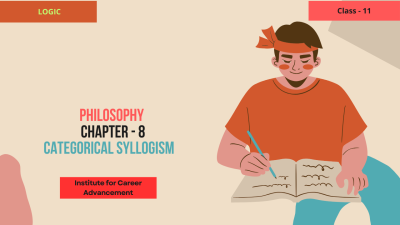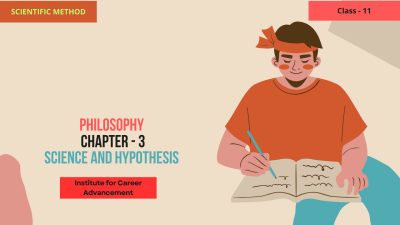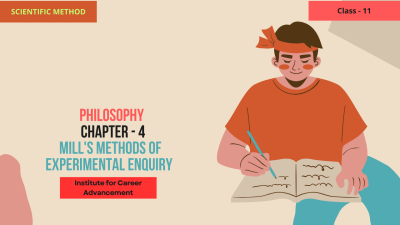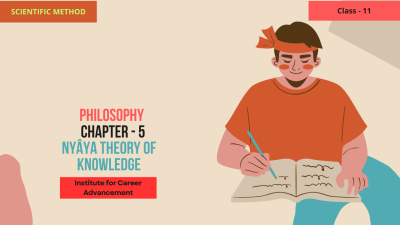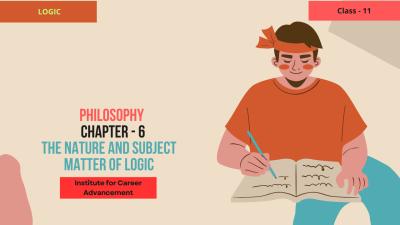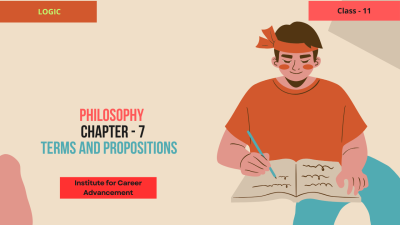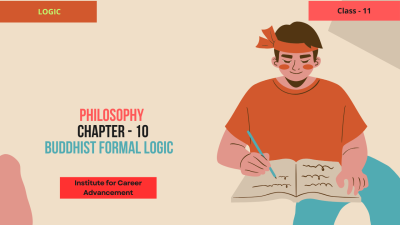Course description
The unit on Categorical Syllogism in Class 11 focuses on one of the most fundamental forms of deductive reasoning. A syllogism is a logical argument that draws a conclusion from two premises. In particular, categorical syllogism deals with statements that assert or deny something about categories or groups of things.
This unit helps students understand how categorical syllogisms work, their structure, and how to use them for logical reasoning and argumentation. It’s essential for developing a deeper understanding of formal logic and its applications in reasoning, argumentation, and decision-making.
Key Concepts Covered:
1. Introduction to Categorical Syllogism
Definition of Syllogism: A syllogism is a form of reasoning in which a conclusion is drawn from two premises.
Categorical Syllogism: A syllogism where both premises and the conclusion are categorical propositions (e.g., "All A are B," "No A are B").
Example:
Major Premise: All humans are mortal.
Minor Premise: Socrates is a human.
Conclusion: Socrates is mortal.
2. The Structure of Categorical Syllogism
Three Terms: Every syllogism has three terms—Major Term, Minor Term, and Middle Term.
Major Term: The predicate of the conclusion.
Minor Term: The subject of the conclusion.
Middle Term: The term that appears in both premises but not in the conclusion.
Example:
Major Premise: All mammals are warm-blooded (Major term: "warm-blooded").
Minor Premise: All humans are mammals (Minor term: "humans").
Conclusion: All humans are warm-blooded.
3. Types of Categorical Propositions
Categorical syllogisms use four types of categorical propositions, classified by their quantity and quality:
A (Universal Affirmative): "All S are P" (e.g., "All birds are animals").
E (Universal Negative): "No S are P" (e.g., "No cats are reptiles").
I (Particular Affirmative): "Some S are P" (e.g., "Some dogs are friendly").
O (Particular Negative): "Some S are not P" (e.g., "Some humans are not athletes").
4. Rules for Valid Categorical Syllogisms
There are specific rules that must be followed for a syllogism to be valid:
The syllogism must contain exactly three terms.
The middle term must be distributed at least once in the premises.
If a term is distributed in the conclusion, it must also be distributed in the premises.
A valid syllogism cannot have two negative premises.
A valid syllogism cannot have a negative conclusion if the premises are both affirmative.
5. Venn Diagrams in Categorical Syllogisms
Venn diagrams are used to visually represent categorical syllogisms, helping to clarify the relationships between the terms.
Venn diagrams allow students to assess whether the premises and conclusion are logically consistent.
6. Types of Categorical Syllogisms
Valid Categorical Syllogisms: These follow the rules of logical deduction and have a true conclusion.
Invalid Categorical Syllogisms: These break one or more of the logical rules, leading to an incorrect or false conclusion.
Common forms of valid categorical syllogisms include:
Barbara (AAA-1): All A are B, All B are C, therefore All A are C.
Celarent (EAE-1): No A are B, All B are C, therefore No A are C.
Darii (AII-1): All A are B, Some B are C, therefore Some A are C.
Conclusion:
The unit on Categorical Syllogism provides students with the tools to engage in formal logical reasoning, ensuring that conclusions are drawn from premises in a valid manner. By mastering the structure of syllogisms, students will enhance their ability to analyze arguments, think critically, and apply logic to various aspects of life and academic pursuits.
একাদশ শ্রেণিতে শ্রেণীগত সিলেজিজমের ইউনিটটি অবরোহী যুক্তির অন্যতম মৌলিক রূপের উপর দৃষ্টি নিবদ্ধ করে। সিলেজিজম হল একটি যৌক্তিক যুক্তি যা দুটি প্রেক্ষাপট থেকে একটি উপসংহার টানতে পারে। বিশেষত, শ্রেণীবদ্ধ সিলেজিজম এমন বিবৃতিগুলির সাথে সম্পর্কিত যা বিভাগ বা জিনিসগুলির গোষ্ঠী সম্পর্কে কিছু দাবি করে বা অস্বীকার করে।
এই ইউনিটটি শিক্ষার্থীদের বুঝতে সাহায্য করে যে শ্রেণীবদ্ধ সিলেজিজমগুলি কীভাবে কাজ করে, তাদের কাঠামো এবং যৌক্তিক যুক্তি ও যুক্তির জন্য কীভাবে তাদের ব্যবহার করা যায়। আনুষ্ঠানিক যুক্তি এবং যুক্তি, যুক্তি এবং সিদ্ধান্ত গ্রহণে এর প্রয়োগ সম্পর্কে গভীর বোঝার বিকাশের জন্য এটি অপরিহার্য।
অন্তর্ভুক্ত মূল ধারণাগুলিঃ
1টি। শ্রেণীগত সিলেজিজমের পরিচিতি
সিলেজিজমের সংজ্ঞাঃ সিলেজিজম হল যুক্তির একটি রূপ যেখানে দুটি পরিসর থেকে একটি উপসংহার টানা হয়।
শ্রেণীগত সিলেজিজমঃ একটি সিলেজিজম যেখানে প্রাঙ্গণ এবং উপসংহার উভয়ই শ্রেণীবদ্ধ প্রস্তাবনা। (e.g., "All A are B," "No A are B").
উদাহরণঃ
প্রধান ভিত্তিঃ সমস্ত মানুষই মরণশীল।
ছোট প্রেক্ষাপটঃ সক্রেটিস একজন মানুষ।
উপসংহারঃ সক্রেটিস মরণশীল।
2. শ্রেণীগত সিলেজিজমের কাঠামো
তিনটি শর্তঃ প্রতিটি সিলেজিজমের তিনটি পদ রয়েছে-মেজর টার্ম, মাইনর টার্ম এবং মিডল টার্ম।
মেজর টার্মঃ উপসংহারের পূর্বাভাস।
মাইনর টার্মঃ উপসংহারের বিষয়।
মধ্য মেয়াদিঃ যে শব্দটি উভয় প্রাঙ্গণে উপস্থিত হয় কিন্তু উপসংহারে নয়।
উদাহরণস্বরূপঃ প্রধান প্রাঙ্গণঃ সমস্ত স্তন্যপায়ী উষ্ণ রক্তের হয়। (Major term: "warm-blooded").
ক্ষুদ্র ভিত্তিঃ সমস্ত মানুষই স্তন্যপায়ী প্রাণী। (Minor term: "humans").
উপসংহারঃ সব মানুষই উষ্ণ রক্তের।
3. বিভাগীয় প্রস্তাবের প্রকার
শ্রেণীগত সিলেজিজমগুলি তাদের পরিমাণ এবং গুণমান দ্বারা শ্রেণীবদ্ধ চার ধরনের শ্রেণীগত প্রস্তাবনা ব্যবহার করেঃ
এ (সর্বজনীন ইতিবাচক) "সমস্ত এস পি" (e.g., "All birds are animals").
ই (সর্বজনীন নেতিবাচক) "না এস হল পি" (e.g., "No cats are reptiles").
আমি (বিশেষভাবে নিশ্চিত) "কিছু এস হল পি" (e.g., "Some dogs are friendly").
ও (বিশেষ নেতিবাচক) "কিছু এস পি নয়" (e.g., "Some humans are not athletes").
4. বৈধ শ্রেণীগত সিলেজিজমের জন্য নিয়ম
একটি সিলেজিজম বৈধ হওয়ার জন্য নির্দিষ্ট নিয়ম রয়েছে যা অবশ্যই অনুসরণ করতে হবেঃ
সিলেজিজমে অবশ্যই ঠিক তিনটি পদ থাকতে হবে।
মাঝারি মেয়াদটি অন্তত একবার প্রাঙ্গনে বিতরণ করতে হবে।
উপসংহারে যদি কোনও মেয়াদ বন্টন করা হয়, তবে তা অবশ্যই প্রাঙ্গণেও বন্টন করতে হবে।
একটি বৈধ সিলেজিজমের দুটি নেতিবাচক ভিত্তি থাকতে পারে না।
একটি বৈধ সিলেজিজমের নেতিবাচক উপসংহার হতে পারে না যদি প্রাঙ্গণ উভয়ই ইতিবাচক হয়।
5. ভেন্ন ডায়াগ্রামস ইন ক্যাটাগরিকাল সিলজিজম
ভেন রেখাচিত্রগুলি শ্রেণীবদ্ধ শব্দাংশগুলিকে দৃশ্যমানভাবে উপস্থাপন করতে ব্যবহৃত হয়, যা পদগুলির মধ্যে সম্পর্ককে স্পষ্ট করতে সহায়তা করে।
ভেন রেখাচিত্রগুলি শিক্ষার্থীদের মূল্যায়ন করতে দেয় যে প্রাঙ্গণ এবং উপসংহার যৌক্তিকভাবে সামঞ্জস্যপূর্ণ কিনা।
6টি। শ্রেণীগত সিলেজিজমের প্রকার
বৈধ শ্রেণীগত সিলেজিজমঃ এগুলি লজিক্যাল ডিডাকশনের নিয়ম অনুসরণ করে এবং এর একটি সত্য উপসংহার রয়েছে।
অবৈধ শ্রেণীগত সিলেজিজমঃ এগুলি এক বা একাধিক যৌক্তিক নিয়ম ভঙ্গ করে, যার ফলে একটি ভুল বা ভুল উপসংহার হয়।
বৈধ শ্রেণীগত শব্দাংশের সাধারণ রূপগুলির মধ্যে রয়েছেঃ
বারবারা (এএএ-1) সমস্ত এ হল বি, সমস্ত বি হল সি, তাই সমস্ত এ হল সি।
সেলারেন্ট (EAE-1) কোন A হল B, সব B হল C, তাই কোন A হল C।
দারি (এআইআই-1) সমস্ত এ হল বি, কিছু বি হল সি, তাই কিছু এ হল সি।
উপসংহারঃ শ্রেণীগত সিলেজিজমের ইউনিটটি শিক্ষার্থীদের আনুষ্ঠানিক যৌক্তিক যুক্তিতে জড়িত হওয়ার সরঞ্জাম সরবরাহ করে, এটি নিশ্চিত করে যে একটি বৈধ পদ্ধতিতে প্রাঙ্গণ থেকে সিদ্ধান্ত নেওয়া হয়। সিলেজিজমের কাঠামোতে দক্ষতা অর্জনের মাধ্যমে, শিক্ষার্থীরা যুক্তি বিশ্লেষণ, সমালোচনামূলক চিন্তাভাবনা এবং জীবনের বিভিন্ন দিক এবং একাডেমিক অনুসরণে যুক্তি প্রয়োগ করার ক্ষমতা বাড়িয়ে তুলবে।

